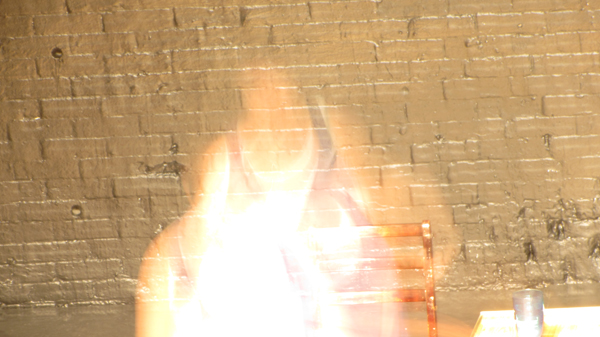Filming “Lost and Found” Part 1: Intro
Back in 2014 I pitched the concept of filming Marilla Wex’s Lost and Found at the Toronto Fringe Festival as an experiment to see if a show could be taped with a vintage ENG tube video camera in challenging lighting conditions (low light); whether the material could be edited within a (relatively) contemporary system (the choice this round was Final Cut Pro 7, because I wanted to see how well Pro Res would handle interlaced footage); and if the whole endeavor could be packaged like a commercial project, with mixed 2.0 and 5.0 sound mixes, and maybe some related extras aimed for a final DVD / Blu-ray for the artist.
The following series of short blogs – about 5-6 – will chronicle the whole project with assorted stills, anecdotes, and practical making-of details on the gear used, the location’s camera positions and challenges in editing the footage, designing Main / End Titles based on Kurt Firla’s really beautiful poster design, sound designing the stereo audio into a 5.0 mix plus some necessary noise scrubbing and volume EQ’ing, and assembling the whole thing into a viewable DVD / Blu-ray.
The first question most readers will ask is ‘Why SD?’ and the answer lies in a curiosity to see what a contemporary play (which thematically deals with coning to terms with the past and ultimately building a new life) would like through the lens of a late-80s camera.
I also figured there might artists who may seek a different’ look,’ in whole or as part of an overall visual design, for a work (a play, a dance project, monologue, or music video) that doesn’t resemble the average crisp, green or amber-hued HD production with familiar graphics .
There’s also the feasibility issue, as to whether something wholly analogue can be incorporated into a digital environment, bounced back to analogue, and finalized in digital. Full confession: the cost of high-end, current broadcast quality SD-to-HD convergence gear is beyond my scope (although I have some unique gizmos), and not every advertised all-in-one solution may give the best results.
Just as one selects the best film stock, HD camera, lenses, and colour grading scheme to suit the unique requirements of a project, the same may apply to an SD-HD convergence. Besides, sometimes the best environment to find unique solutions is one where the limitations are insane.
The key point to remember when choosing to capture material in SD is that it’ll never be HD. To up-res to 1080p magnifies flaws, of which some you may want (given they’re part of the originating format) and others you really, really don’t.
I’ll get into more specifics in a later blog, but suffice it to say that you can only magnify a lo-res image so much before it gets soft, smeary, and ultimately ugly. If you stick within the parameters of SD, stepping a little bit into a slightly higher resolution that’s at the tip of HD, it can look fine, and quite retro.
The reason some filmmakers may choose to originate in SD or opt for a hybrid solution is purely aesthetic: you want a retro look that doesn’t resemble a batch of plugins and filters that still feel a little synthetic in spite of their qualitative virtues.
There’s also the issue of time (loading presets versus testing & fiddling assorted gear), and one’s own preference for clicking and applying versus patiently handling chunky gear are also part of the attraction, if not the novelty of using something that’s a certifiable antique, yet delivers what could be described as the purest form of analogue – the kind of image you can’t get from filming footage off a HD monitor.
The best-known work that illustrates the uniqueness and headaches in one SD package is Andrew Bujalski’s Computer Chess (2013), because that eerie look has to come from an inherently quirky vidicon tube camera (built when Nixon was still President). It’s no different than using a vintage synthesizer in a music piece, mixing and / or engineering the final product in a digital environment to retain as much information of the analogue sound as possible.
Craig Safan’s Warning Sign was composed & performed in 1985, and while transferred to digital, nothing sounds like it.
I’ve posted a demo edit of the footage from Wex’s Lost and Found, with select scene extracts from the first half that don’t spoil what lies in the second, emotionally potent half. The Intro Prologue, Main Titles and End Credits haven’t been reduced, making the demo’s running time about 19 minutes.
Qualitatively, the larger file is on YouTube, but Vimeo’s compression is less severe, so it’s a slight trade-off between the two, since the same file on Vimeo had to be a hair below 500 MB, and the YT upload was around 900 MB. The full performance runs under an hour, and as an uncompressed MP4 file, is about 13GB.
Not unlike Computer Chess, if knocked the file down to DVD, MPEG will restrict the info, but on Blu, you can offer a file much closer to the video’s full size.
Vimeo:
YouTube:
In the next installment, I’ll reset to the very beginning, and discuss prepping, lugging the gear (a JVC BY-110U camera, tripod, Sony miniDV recorder, Zoom audio recorder), setting up, and filming Wex’s play twice at the Theatre Passe Muraille Backspace.
Thanks for reading,
Mark R. Hasan, Editor
Big Head Amusements

